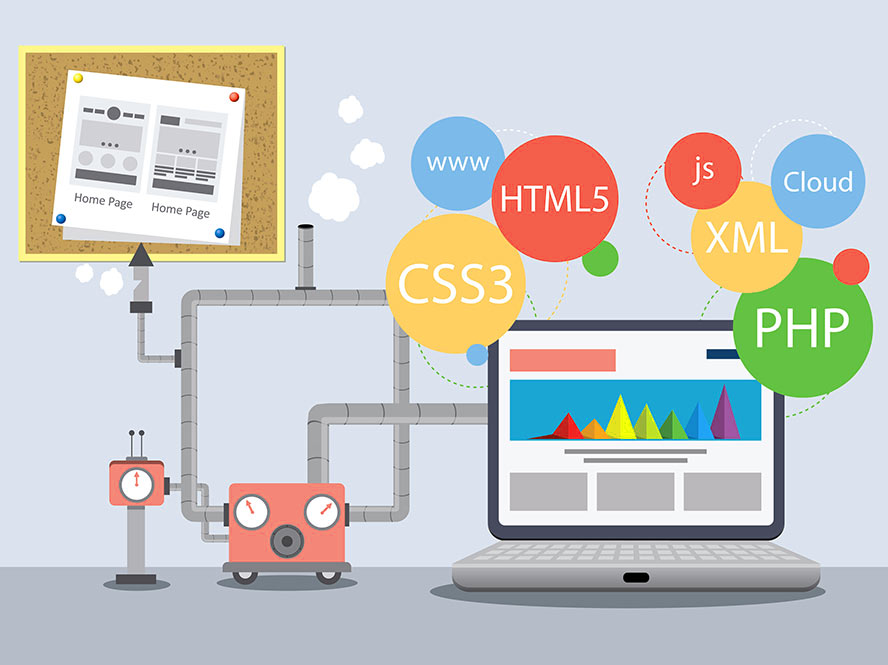Beginners’ guide to web technologies in 2022

You’re probably aware that computers do not converse with one another in the same manner that people do. Computers, on the other hand, require codes or instructions. Computers can process information with the use of binary codes and commands. Hundreds of billions of ones and zeros are processed every second to give you the information you require.
So, what does this have to do with your capacity to upload your most recent photos to the internet? Everything.
Web technology refers to the ways by which computers connect using markup languages and multimedia packages. Web technology has evolved dramatically over the last few decades, from a few marked-up web pages to the capacity to execute extremely precise work on a network without interruption.
For a perfect and reliable website, get Website Development Services from experts at top-notch website development agencies.
WEB TECHNOLOGY CLASSIFICATION:
WORLD WIDE WEB (WWW):
Web browsers, Hypertext Markup Language (HTML), and Hypertext Transfer Protocol (HTTP) are among the technologies that make up the World Wide Web (HTTP).
WEB BROWSERS:
The web browser is a piece of software that allows you to browse the internet (World Wide Web). It acts as a conduit between the server and the client, allowing requests for web documents and services to be sent to the server.
When you type a URL into the address bar of a browser, it sends your request to the server, which then fetches and shows whatever the user requested.
- Google Chrome, The most popular browser is now Chrome, which is given to you by Google.
- Safari, The web browser from Apple.
- Firefox, Mozilla Foundation-supported open-source browser
- Internet Explorer The browser from Microsoft. This is one that web developers frequently complain about.
WEB PAGES:
A website is a digital document linked to the World Wide Web and readable by anyone with a web browser who is connected to the internet.
WEB DEVELOPMENT:
Web development is the process of producing websites and apps for the internet or intranets or private networks. Web design, web publishing, web development, and database management are all included. It all comes down to the look and feel of the website.
Web Development Classification:
Web Development can be classified in two ways,
-
BACK END DEVELOPMENT
The backend is the polar opposite of that. It is concerned with the hidden mechanisms that allow a website to work. The average user has no idea what’s going on behind the scenes.
-
FRONT END DEVELOPMENT
The term “frontend” refers to all of the pieces of a website that a user can view and interact with on their screen.
BACK END LANGUAGES
1. JAVA
Java is a widely-used programming language in business. It runs on a variety of systems, has extensive documentation, and is maintained by Oracle (a well-known software business) in the event of a problem. It’s also possible to utilize it to create Android apps.
2. PYTHON
Python has been around for a long time, but it is only recently gaining popularity because of its simple, legible syntax and great productivity. A task that could take ten lines of code in another programming language could be accomplished in as little as two lines of Python code.
Python is frequently used in conjunction with the Django or Flask frameworks for server-side web development, which makes the process even easier.
3. RUBY
Ruby on Rails is a server-side internet solution that simplifies and accelerates app development. The reusability of the code, as well as some other cool features, are what set this framework apart. They will help you get the job done in no time. Basecamp, Ask.FM, GitHub, 500px, and a slew of other popular Ruby-based websites are just a few examples.
4. PHP
In web development, PHP is the most widely used language. PHP is the foundation of WordPress, a content management system (CMS) that runs 34% of the Internet. Finding a decent developer is challenging no matter what language you choose, but choosing a popular one like PHP will provide you with a broader pool of professionals to choose from and collaborate with. For troubleshooting and support, PHP comes with copious online documentation and tutorials.
5. RUST
Rust is a modern programming language that emphasizes safety, particularly safe concurrency. In software engineering, concurrency refers to a set of techniques that allow a computer program to complete many tasks at the same time. Safe concurrency allows you to do numerous activities efficiently while keeping your code safe and secure. Rust is a high-performing language that has achieved market momentum despite its youth.
You may also like: Built the web growth fast with SEO services
FRONT END LANGUAGES
1. HTML
HTML stands for Hypertext Markup Language. It defines a website’s structure so that web browsers know what to display.
2. CSS
CSS allows site designers to alter the web’s colors, fonts, animations, and transitions. They make the internet appear nice.
LESS is a CSS pre-compiler that makes CSS easier to work with and adds functionality.
SASS is a pre-compiler for CSS that makes it easier to work with and adds features.
3. JAVASCRIPT
In 1995, the first version of JavaScript was released. It is now a favorite among developers all around the world. It is currently an important part of web development that aids in the creation of dynamic web page elements.
With the arrival of JavaScript, a new generation of interactive websites was born. The development of JavaScript has made it easy to include graphical components, database integration, and overall website dynamics.
4. AJAX
The acronym Ajax stands for Asynchronous Javascript and XML. It’s used to communicate with the server without having to refresh the page, resulting in a better user experience and performance.
There are a variety of alternative languages that can be used to construct front-end applications, depending on the framework. For example, Flutter utilizes Dart, React uses JavaScript, and Django uses Python, among others.
WEB PROTOCOLS
Protocols define how data is exchanged between computers. Furthermore, HTTPS is the protocol used by a browser to communicate with a website. It is, after all, the primary means through which information is transmitted over the internet. There are two recent protocols:
DDP — is a new Meteor-related protocol that establishes a consistent socket connection between the client and the server.
REST (Representational State Transfer) is an API protocol.
FRAMEWORK
Frameworks automate repetitive development procedures or make programming tasks more straightforward. Frameworks are available for both server-side and client-side web development. Different frameworks are required for different programming languages. Among the server-side frameworks are:
- Node.js,
- Ruby on Rails,
- .Net
- Django
- Yee
- Zend
- Larval
JavaScript is supported by many front-end frameworks, including
- Angular.js
- Ember.js
- Backbone.js
- Express.js
- Vue.js
DATA FORMATS
Data formats are used to organize data storage. Although most Microsoft systems still utilize XML, JSON is becoming more common. CSV is a comma-delimited data format that is primarily utilized by spreadsheet programs like Excel.
CONCLUSION
Business owners and marketers can be more involved in the development process if they have a working knowledge of the technology utilized in web development. They won’t need to memorize any of the above, but having this article on hand will equip them with some of the technical information they’ll need to make good project decisions.
The key to selecting the correct web development technologies is in selecting the right partner to carry out your project.






One Comment